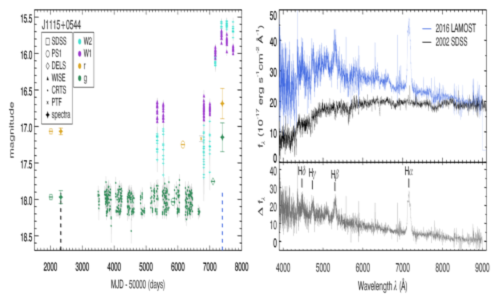The rare case of changing-look (CL) active galactic nuclei (AGNs), with the appearance or disappearance of broad Balmer emission lines within a few years, challenges our understanding of the AGN unification model. Based on this model, Type 1 (with broad lines) and Type 2 (without broad lines) are viewed at different orientations. It’s hard to change between Type 1 and Type 2 AGNs at short time scales.
The physical mechanisms of CL AGNs are still under debate. The main plausible mechanisms are (1) variable obscuration due to the movement of obscuring material; (2) variable accretion rate, in an evolutionary paradigm in which an AGN follows an evolutionary sequence from Type 1 to intermediate type and later to Type 2, or vice versa; or (3) a tidal disruption event (TDE) of a star disrupted by the supermassive black hole (SMBH), which may also result in a change of classification.
A research team, led by Prof. Xue-Bing Wu from Peking University, discovered 21 new CL AGNs at 0.08 < z < 0.58, which doubles the number of such objects known to date. Among them, 10 CL AGNs were discovered using the LAMOST spectra. The result was published in the Astrophysical Journal on August 1st, 2018, with Qian Yang, a newly graduated PhD student, being the first author of the paper.
From this sample, the estimated upper limits of the transition timescale of the CL AGNs spans from 0.9 to 13 years in the rest-frame. The continuum flux in the optical and mid-infrared becomes brighter when the CL AGNs turn on, or vice versa. The optical and mid-infrared variability is not consistent with the scenario of variable obscuration in 10 CL AGNs at more than the 3σ confidence level. They confirmed a bluer-when-brighter trend in the optical. However, the mid-infrared colors become redder when the objects become brighter in the shorter wavelength mid-infrared band, possibly due to a stronger hot dust contribution in the longer wavelength mid-infrared band when the AGN activity becomes stronger.
The physical mechanism of type transition is important for understanding the evolution of AGNs. Astronomers are searching and observing more CL AGNs, in order to understand better the physical mechanism behind the type transition of these rare objects.
The link of the paper: http://iopscience.iop.org/article/10.3847/1538-4357/aaca3a


Address: 20A Datun Road, Chaoyang District, Beijing, China code: 100012
Tel: 010-64888708 E-mail: naoc@nao.cas.cn

